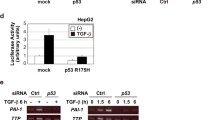Abstract.
Although Evi-1 is thought to promote growth or block differentiation in some cell types, its biological functions have not been elucidated. To explore the mechanisms underlying Evi-1-induced oncogenesis, we investigated whether Evi-1 affects the signaling of transforming growth factor β (TGF-β), which inhibits proliferation of a wide range of cell types and is one of the most studied growth regulatory factors. We demonstrated that Evi-1 represses TGF-β signaling and antagonizes its growth-inhibitory effects. Two separate regions of Evi-1 are responsible for this repression, one of which is the first zinc-finger domain. Through this domain, Evi-1 physically interacts with Smad3, an intracellular mediator of TGF-β signaling, thereby suppressing the transcriptional activity of Smad3. These results define a novel function of Evi-1 as a repressor of signaling components of TGF-β. We also demonstrated that Evi-1 represses Smad-induced transcriptional activation by recruiting CtBP as a corepressor. Evi-1 associates with CtBP1 through one of the CtBP-binding consensus motifs within the region from amino acid 544 to 607, and this association is required for the efficient inhibition of TGF-β signaling. A specific histone deacetylase (HDAc) inhibitor, trichostatin A (TSA), alleviates Evi-1-mediated repression of TGF-β signaling, suggesting that HDAc is involved in transcriptional repression by Evi-1. This identifies a novel function of Evi-1 as a member of corepressor complexes and suggests that aberrant recruitment of corepressors is one of the mechanisms involved in Evi-1-induced leukemogenesis. These results indicate that specific HDAc inhibitors may be useful in the treatment of Evi-1-induced neoplastic tumors, including myeloid leukemias.
Access this article
We’re sorry, something doesn't seem to be working properly.
Please try refreshing the page. If that doesn't work, please contact support so we can address the problem.
Similar content being viewed by others
Author information
Authors and Affiliations
Additional information
Electronic Publication
Rights and permissions
About this article
Cite this article
Hirai, H., Izutsu, K., Kurokawa, M. et al. Oncogenic mechanisms of Evi-1 protein. Cancer Chemother Pharmacol 48 (Suppl 1), S35–S40 (2001). https://doi.org/10.1007/s002800100303
Issue Date:
DOI: https://doi.org/10.1007/s002800100303




